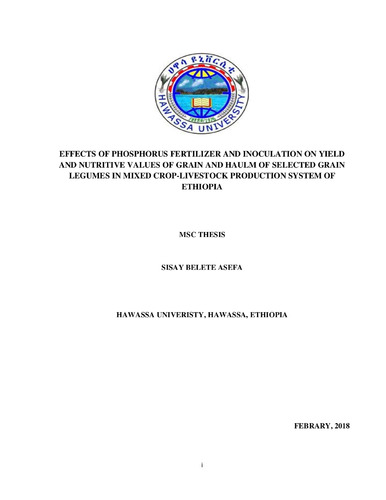Effects of phosphorus fertilizer and inoculation on yield and nutritive values of grain and haulm of selected grain legumes in mixed crop-livestock production system of Ethiopia
Abstract
A study was conducted to evaluate the effects of phosphorus fertilizer and inoculants application on yield and nutritional quality of grain and haulm of selected grain legumes and to assess farmers’ grain legumes haulm use practices and their perception on the effects of phosphorus fertilizer and inoculation on haulm yield and quality. The study involved field experiment and household survey. For the field experiment, four grain legumes (faba bean, chickpea, haricot bean and soybean) were subjected to four fertilizer treatments (inoculation + P fertilizer (+P+I), inoculation alone (-P+I), P fertilization alone (+P-I) and control i.e. no inoculation and no fertilizer (-P-I)) on individual farmer plots. Grain and haulm yield data were recorded and subsequently representative samples were collected for quality analysis in the laboratory. A semi-structured questionnaire was administered to collect data on household characteristics. Analysis of variance was run in general linear model of SAS for experimental data in randomized complete block design and household data was analyzed using descriptive statistics of SPSS. Faba bean grain and haulm DM yield were significantly improved (P<0.05) due to the treatments and the highest mean grain yield (2.87 and 2.84 t/ha) were obtained from +P-I and +I+P treatments, while the maximum haulm DM yield (3.61 t/ha) was recorded in treatment +P+I. Faba bean haulm CP content, IVOMD and ME values of treatment +P+I, -P+I and +P-I were found to significantly (P<0.05) surpass the control, whereas treatment +P+I, -P+I and +P-I resulted the lowest mean haulm NDF, ADF and ADL content than the control. Application of rhizobium inoculants and P fertilizer had a highly significant effect (P<0.001) on grain yield but non-significant effect (P>0.05) on haulm DM yield of chickpea. The maximum mean grain yield (2.13 t/ha and 1.98 t/ha) of chickpea was recorded in treatment +I+P and +I-P, respectively. The haulm CP, IVOMD and ME contents of chickpea responded positively (P<0.05) to the treatments, but the responses of ash, NDF, ADF and ADL content were not significant (P>0.05). The highest mean grain (1.98 t/ha) and haulm DM (1.84 t/ha) yield of haricot bean was obtained from treatment +P+I. Treatment +P+I was also resulted into significantly high (P<0.05) haulm ash and CP contents, and IVOMD and ME values of haricot bean, while the same treatment (+P+I) had lower NDF and ADF contents than the others. In soybean, significantly maximum mean grain (2.56 and 2.46 t/ha) and haulm DM (3.07 and 3.23 t/ha) yield were recorded in treatments +P+I and -P+I, respectively. Except haulm ash content and ME value, all feed quality variables analyzed (CP, NDF, ADF, ADL and IVOMD) were significantly (P<0.05) affected due to the treatments in soybean. The maximum mean values of soybean haulm CP and IVOMD were obtained in the inoculated treatments (+P+I and –P+I), meanwhile treatment +P+I contained the lowest NDF, ADF and ADL. The result also showed that households used grain legume haulms as a source of feed (76.7%), fuel (11.4%), for mulching and compost making (8.8%) and income generation (3.1%). Majority of the respondents (62.2%) perceived that inoculation and P fertilization positively affects haulm biomass yield. The current results demonstrated the possibility of improving both grain and haulm yield and quality of faba bean, haricot bean and soybean by using rhizobium inoculants and P fertilizer. Moreover, regardless of haulm yield and haulm fiber contents; improvement of grain yield of chickpea is also possible by the use of combined rhizobium inoculants and P fertilizer.

